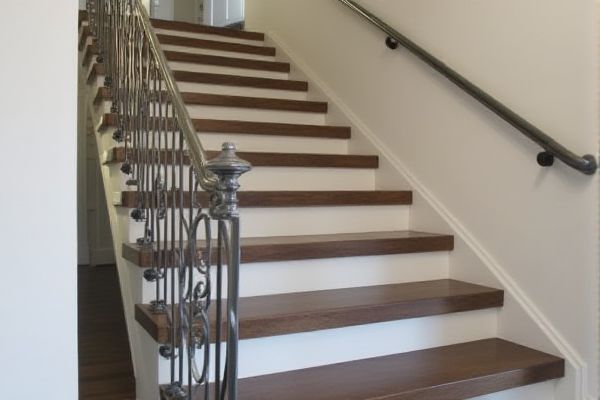
Powder-coated finish stairs offer a durable, corrosion-resistant surface with a wide range of color options, making them ideal for both indoor and outdoor applications, while anodized finish stairs provide enhanced metal protection through an electrochemical process that increases resistance to wear and fading without adding a color layer. Discover how these finishes impact the longevity, appearance, and maintenance of your stairs by reading the rest of this article.
Table of Comparison
| Feature | Powder-Coated Finish Stairs | Anodized Finish Stairs |
|---|---|---|
| Durability | High resistance to chipping, scratching, and fading | Excellent corrosion resistance with a hard, durable surface |
| Appearance | Available in a wide range of colors and textures | Metallic, glossy finish with limited color palette |
| Maintenance | Easy to clean; may require touch-ups over time | Low maintenance; preserves finish for years |
| Cost | Generally more affordable | Typically more expensive due to anodizing process |
| Environmental Resistance | Good outdoor weather resistance; may degrade under intense UV | Excellent UV and corrosion resistance for outdoor use |
| Application Process | Electrostatic spray with heat curing | Electrochemical oxidation process |
Introduction to Stair Finishes
Powder-coated finish stairs provide a durable, corrosion-resistant surface with a wide range of color options, enhancing both aesthetics and longevity. Anodized finish stairs offer a sleek, metallic appearance with increased resistance to abrasion and wear due to the electrochemical process strengthening the aluminum surface. Both finishes improve stair durability but differ in texture, maintenance, and visual appeal, making them suitable for various architectural and functional requirements.
What is Powder-Coated Finish?
Powder-coated finish is a durable, protective coating applied as a free-flowing, dry powder that is electrostatically sprayed onto stairs and then cured under heat to form a hard, smooth layer resistant to chipping, fading, and corrosion. This finish offers excellent color consistency and can withstand harsh environmental conditions, making it ideal for both indoor and outdoor stair applications. If you're looking to enhance your stairs with a vibrant, long-lasting surface, powder coating provides superior protection compared to anodized finishes, especially in terms of impact resistance and color variety.
What is Anodized Finish?
An anodized finish is an electrochemical process that enhances aluminum stairs by creating a durable, corrosion-resistant oxide layer on the surface. This finish improves scratch resistance and maintains a metallic appearance, making it ideal for outdoor or high-traffic environments. Your choice between powder-coated and anodized finishes depends on whether you prioritize vibrant colors and thicker coatings or long-lasting metallic protection.
Durability Comparison: Powder-Coated vs Anodized Stairs
Powder-coated stairs offer a thicker, more impact-resistant layer that protects against chipping, scratching, and corrosion, making them highly durable for heavy foot traffic environments. Anodized finishes create a hard, protective oxide layer on metal surfaces, providing excellent resistance to wear and oxidation but may be less resilient against physical damage compared to powder coating. Choosing your stair finish depends on the balance between abrasion resistance and exposure to environmental factors, with powder coating excelling in impact protection and anodizing offering superior corrosion resistance.
Color and Aesthetic Options
Powder-coated finish stairs offer a wide spectrum of vibrant color choices and customizable textures, providing excellent durability against chipping and fading, which enhances the visual appeal in both indoor and outdoor settings. Anodized finish stairs present a sleek, metallic look with limited color variations, primarily in natural tones such as silver, black, and bronze, delivering corrosion resistance and a subtle sheen that complements modern architectural designs. Your selection should balance the desired aesthetic flexibility with the maintenance requirements and environmental exposure of the stair area.
Maintenance Requirements for Each Finish
Powder-coated finish stairs require minimal maintenance, needing only periodic cleaning with mild soap and water to prevent dirt buildup and maintain their vibrant color. Anodized finish stairs offer superior resistance to corrosion and wear, but may show scratches more easily and benefit from gentle cleaning with non-abrasive materials to preserve the protective oxide layer. Your choice should consider how much upkeep you're willing to perform, as powder coating typically offers easier long-term maintenance compared to anodizing.
Environmental Impact and Sustainability
Powder-coated finish stairs produce fewer volatile organic compounds (VOCs) and generate less hazardous waste compared to anodized finishes, making them more environmentally friendly in terms of emissions and chemical usage. Anodized finishes, while energy-intensive due to the electrochemical process, offer excellent durability and corrosion resistance, potentially reducing the frequency of replacements and maintenance over time. Both finishes contribute to sustainability by extending stair lifespan, but powder coating's lower emission profile often positions it as the greener choice in eco-conscious construction.
Cost Differences and Budget Considerations
Powder-coated finish stairs typically offer a more cost-effective solution compared to anodized finishes, with prices generally 20-40% lower due to less complex application processes. Budget considerations favor powder coating for large projects or areas requiring vibrant color options and durability against corrosion and wear. Anodized finishes, while more expensive, provide superior resistance to scratching and UV exposure, justifying higher costs in high-traffic or outdoor stair environments where long-term maintenance savings are crucial.
Best Applications for Powder-Coated and Anodized Stairs
Powder-coated finish stairs offer excellent durability and vibrant color options, making them ideal for outdoor and high-traffic environments where resistance to corrosion and UV exposure is critical. Anodized finish stairs provide a sleek, metallic appearance with enhanced surface hardness, making them suitable for indoor settings requiring wear resistance and minimal maintenance. Choosing between powder-coated and anodized finishes depends on exposure conditions, aesthetic preferences, and long-term performance requirements.
Choosing the Right Finish for Your Stair Project
Powder-coated finish stairs offer superior durability and resistance to chipping, fading, and scratching, making them ideal for high-traffic areas and outdoor installations. Anodized finish provides enhanced corrosion resistance and a sleek, metallic appearance while maintaining the natural aluminum base, which is perfect for modern indoor stair designs. Your choice depends on whether you prioritize vibrant color longevity and toughness (powder coating) or natural metal aesthetics with added protection (anodizing).
 homyna.com
homyna.com